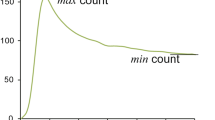Abstract
In 47 patients with cerebrovascular disease (CVD) a noninvasive determination of global and regional cerebral blood flow (CBF) was performed with the gamma camera. A new approach was developed for region definition and for evaluation of the ‘start-fit-time’ as the point of minimal contamination of the recorded data by extracerebral scatter and recirculation using the region of interest (ROI)-technique in the camera field of view. In comparison with the results of probe measurement of end-tidal exhalation air no significant differences were seen and values obtained were well in the range reported by other authors. Initial slope (IS), gray matter flow (F1) and CBF-15 were used as quantitative parameters and were able to distinguish significantly(P<0.001) between normals, patients with mild CVD, and severe CVD. Intraexamination variation coefficient (VC) was 5%, interexamination VC was 8%. Functional, parametric images of wash-in for easier ROI-definition and judgement of isotope supply and of wash-out were generated by a computer analysis and were found to be sensitive indicators for arterial blood supply and wash-out city. Thus it was possible to recalculate regional flowes in focal areas exactly corresponding to ab on the functional images. So the regional information of functional images can combined with the quantitative data in selectable areas. By this noninvasive, easily performed method focal neurological deficits can be evaluated with high accuracy with conventional nucl medicine equipment.
Similar content being viewed by others
References
Bruce DA, Schutz M, Vapalahti M, Langfitt TW (1975) Pitfalls in the interpretation of xenon CBF studies in head injured patients. In: Langfitt TW, McHery LC, Reivich M, Wollman H (eds) Cerebral circulation and metabolism. Springer, New York, pp 406–408
Heiss WD, Prosenz P, Roszuczky A (1972) Technical considerations in the use of a gamma-camera 1600 channel analyzer system for the measurement of regional cerebral blood flow. J Nucl Med 13:534–543
Heiss WD, Reisner T, Hoyer I (1975) Changes of compartmental weight in the course of stroke. In: Harper M, Jennet WB, Miller ID, Rowan IO (eds) Blood flow and metabolism in the brain. Churchill Livingstone, Edinburgh, pp 13.10–13.11
Heiss WD, Zeiler K, Havelec L, Reisner T, Bruck J (1977) Longterm prognosis in stroke related to cerebral blood flow. Arch Neurol 34:671–676
Heiss WD (1979) Regional cerebral blood flow measurement using a scintillation camera. Clin Nucl Med 4:385–396
Høedt-Rasmussen U, Sveinsdottier E, Lassen NA (1966) Regional cerebral blood flow determined by intra-arterial injection of radioactive insert gas. Circ Res 18:237–247
Ingvar DH, Lassen NA (1961) Quantitative determination of regional central blood flow in man. A preliminary communication. Lancet 2:806–807
Ingvar DH, Philipson L (1977) Distribution of cerebral blood flow in the dominant hemisphere during motor ideation and motor performance. Ann Neurol 2:230–237
Ingvar DH, Schwartz MS (1974) Blood flow patterns induced in the dominant hemisphere by speech and reading. Brain 97:273–278
Lassen NA, Ingvar DH (1963) Regional cerebral blood flow measurement in man. Arch Neurol 9:615–622
Mallet BL, Veall N (1965) The measurement of regional cerebral clearance rates in man using Xenon-133 inhalation and extracranial recording. Clin Sci 29:179–191
Meyer IS, Ishihara N, Deshmukh VD, Naritomi H, Sakai F, Hsu MC, Pollack P (1978) Improved method for noninvasive measurement of regional cerebral blood flow by 133Xenon inhalation. Part I: Description of method and normal values obtained in healthy voluntears. Stroke 9:195–205
Noelpp UP, Schaad N, Rösler H (1977) Trendszintigraphie. Nucl Med 16:232–237
Obrist WD, Thompson HK, King CH, Wang HS (1967) Determination of regional cerebral blood flow by inhalation of 133-Xenon. Circ Res 20:124–135
Obrist WD, Thompson HK, Wang AS, Wilkinson WE (1975) Regional cerebral blood flow estimated by 133Xenon inhalation. Stroke 6:245–256
Obrist WD, Wilkinson WE (1980) The noninvasive Xe-133 method: Evaluation of CBF indices. In: Bes A, Géraud G (eds), Cerebral circulation and neurotransmitters. Excerpta Medica, Amsterdam - Oxford - Princeton, pp 119–124
Philippon BL, Thisolle PH, Berger M (1980) Effet tomographique dans les images fonctionnelles isotopiques des débits sanguins cŕeébraux régionaux: Visualisation des infarctus profonds, par la methode d'inhalation de 133Xe. In Höfer R, Bergmann H (eds) Radioaktive Isotope in Klinik und Forschung. H. Egermann, Wien, pp 419–424
Reivich M, Obrist WD, Slater R, Greeberg J, Goldberg HI (1975) A comparison of 133Xe intracoratid injection and inhalation techniques for measuring regional cerebral blood flow. In: Harper AM, Jennet WB, Miller ID, Rowan IO (eds), Blood flow and metabolism in the brain. Churchill Livingstone, Edinburg, pp 8.3–8.6
Risberg I, Ali Z, Wilson EM, Wills EL, Halsey IH (1975) Regional cerebral blood flow by 133Xenon inhalation. Stroke 6:142–148
Tojama H, Iisaka J, Chiba K, Yamada H, Matsui K, Hoshi Y, Fuse M (1976) Colour functional images of cerebral blood flow. J Nucl Med 17:953–958
Veall N, Mallet BL (1966) Regional cerebral blood flow determination by 133Xe inhalation and external recording: The effect of arterial recirculation. Clin Sci 30:353–369
Waltz AG, Wanek AR, Anderson RE (1972) Comparison of analytic methods for calculation of cerebral blood flow after intracarotid injection of 133Xe. J Nucl Med 13:66–72
Wyper DI, Lennox GA, Rowan IO (1976) Two minute slope inhalation technique for cerebral blood flow measurement in man. J Neurol Neurosurg Psychiat 39:141–146
Author information
Authors and Affiliations
Rights and permissions
About this article
Cite this article
Sochor, H., Ogris, E., Bruck, J. et al. Noninvasive rCBF determination by 133XE-inhalation with the gamma camera and functional imaging of wash-in and wash-out. Eur J Nucl Med 6, 481–486 (1981). https://doi.org/10.1007/BF00255879
Received:
Issue Date:
DOI: https://doi.org/10.1007/BF00255879




